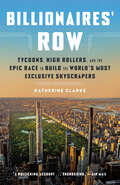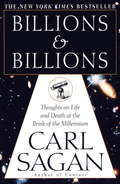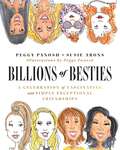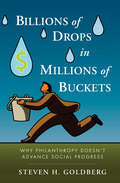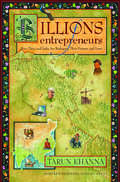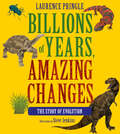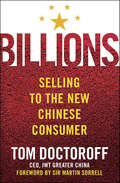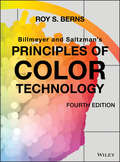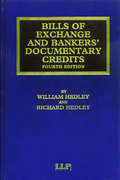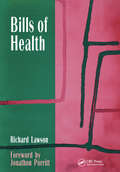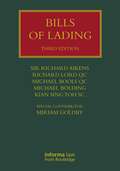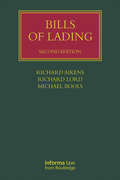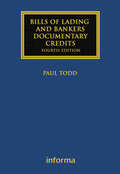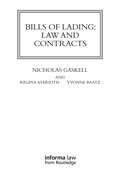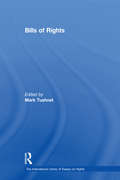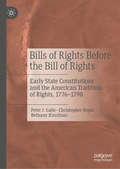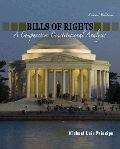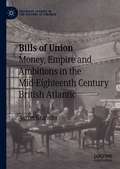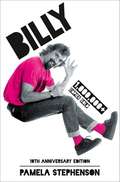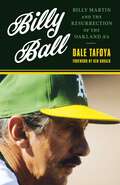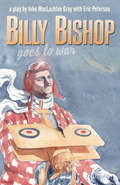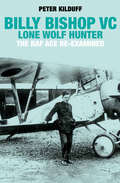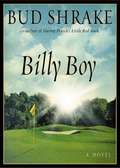- Table View
- List View
Billionaires' Row: Tycoons, High Rollers, and the Epic Race to Build the World's Most Exclusive Skyscrapers
by Katherine ClarkeA fly-on-the-wall account of the ferocious ambition, greed, and financial one-upmanship behind the most expensive real estate in the world: the new Manhattan megatowers known as Billionaires&’ Row—from a staff reporter at The Wall Street Journal&“Deeply informative, delightfully entertaining, and addictively readable.&”—Diana B. Henriques, bestselling author of The Wizard of LiesTo look south and skyward from Central Park these days is to gaze upon a physical manifestation of tens of billions of dollars in global wealth: a series of soaring spires stretching from Park Avenue to Broadway. Known as Billionaires&’ Row, this set of slender high-rise residences has transformed the skyline of New York City, thanks to developer-friendly policies and a seemingly endless gush of cash from tech, finance, and foreign oligarchs. And chances are most of us will never be invited to step inside.In Billionaires&’ Row, Katherine Clarke reveals the captivating story of how, in just a few years, the ruthless real-estate impresarios behind these &“supertalls&” lining 57th Street turned what was once a run-down strip of Midtown into the most exclusive street on Earth, as legendary Trump-era veterans went toe-to-toe with hungry upstart developers in an ego-fueled &“race to the sky.&” Based on far-reaching access to real estate&’s power players, Clarke&’s account brings readers inside one of the world&’s most cutthroat industries, showing how a combination of ferocious ambition and relentless salesmanship has created a new market of $100 million apartments for the world&’s one-percenters—units to live in or, sometimes, just places to stash their cash.Filled with eye-popping stories that bring the new era of extreme wealth inequality into vivid relief, Billionaires&’ Row is a juicy, gimlet-eyed account of the genius, greed, and financial one-upmanship behind the most expensive real estate in the world—a stranger-than-fiction saga of broken partnerships, broken marriages, lawsuits, and, for a few, fleeting triumph.
Billions & Billions: Thoughts on Life and Death at the Brink of the Millennium (Americana Ser.)
by Carl SaganIn the final book of his astonishing career, Carl Sagan brilliantly examines the burning questions of our lives, our world, and the universe around us. These luminous, entertaining essays travel both the vastness of the cosmos and the intimacy of the human mind, posing such fascinating questions as how did the universe originate and how will it end, and how can we meld science and compassion to meet the challenges of the coming century? Here, too, is a rare, private glimpse of Sagan's thoughts about love, death, and God as he struggled with fatal disease. Ever forward-looking and vibrant with the sparkle of his unquenchable curiosity, Billions & Billions is a testament to one of the great scientific minds of our day.From the Trade Paperback edition.
Billions of Besties: A Celebration of Fascinating and Simply Exceptional Friendships
by Peggy Panosh Susie AronsThis beautifully illustrated and joyful tribute celebrates famous friendships (both real and fictional) and proves that there is no relationship more important than friendship. Our best friends are our soulmates. They understand us when no one else does, lift us up, and bring out the best in us. It&’s a relationship based on a bond that can&’t always be described, but is always magical. Billions of Besties shines a light on some of the most engaging, funny, inspiring, and sometimes unexpected sets of friends. In this gorgeous and playfully illustrated volume, creators and besties Peggy and Susie highlight more than 100 besties, both real and fictional, from all walks of life. From the comedic powerhouse of Amy Poehler and Tina Fey, to the unexpected camaraderie between RGB and Antonin Scalia, the glamourous friendship between Anna Wintour and Roger Federer, or the fictional ride-or-die bond between Thelma and Louise, this book is a timeless salute to friendship in all its forms. Uplifting and charming, Billions of Besties celebrates the power and vitality of friendship—from bromances to work wives—reminding us that when we have each other&’s backs, we have the power to change the world.
Billions of Drops in Millions of Buckets
by Goldberg Steven H.Praise for BILLIONS OF DROPS in MILLIONS OF BUCKETS "Billions of Drops in Millions of Buckets provides a bracing and original look at philan-thropy that offers a much-needed corrective to conventional wisdom. Steve Goldberg combines a resolve to understand why so much philanthropy accomplishes so little enduring social change with a timely and serious proposal to reinvigorate nonprofit capital markets through the simplest of insights: getting more of the money to where it can do the most good. This book will change how forward-looking philanthropists, foundations, and policymakers think about the relationship between charitable giving and the transformative capacity of social entrepreneurs. " -Jerr Boschee, founder and Executive Director, The Institute for Social Entrepreneurs; Visiting Professor of the Practice in Social Enterprise, Carnegie Mellon University "Goldberg's arguments are logical next steps in the rapidly evolving discussion of social capital markets. He offers ambitious proposals informed by the reality of current practices and focused on an achievable set of goals. He fully recognizes the potential for restructuring that is inherent in this time of financial hardship. Real change relies on big ideas, and Steve Goldberg offers us several. " -Lucy Bernholz, author of Creating Philanthropic Capital Markets: The Deliberate Evolution "When I first heard about 'evidence-based medicine,' I thought: 'you mean it isn't?' Read this book and that's how you'll feel about 'performance-based philanthropy. ' Goldberg takes some of the best current management thinking and applies it to social enterprise, illuminating both the encouraging successes of social entrepreneurs and the barriers they face. Even better, he presents compelling ideas for making the social sector vastly more effective. " -Christopher Meyer, Chief Executive, Monitor Networks "Goldberg calls for more 'performance-driven philanthropy,' where nonprofits are rewarded based on their results, in place of the current dysfunction. It is an important call and a valuable contribution to discussions about how to improve nonprofits in the U. S. and internationally. " -Martin Brookes, Chief Executive, New Philanthropy Capital "Billions of Drops. . . is a must-read romp through emerging fields of social entrepre-neurship and nonprofit capital markets. " -George Overholser, founder and Managing Director, NFF Capital Partners
Billions of Entrepreneurs
by Tarun KhannaChina and India are home to one-third of the world's population. And they're undergoing social and economic revolutions that are capturing the best minds--and money--of Western business. In Billions of Entrepreneurs, Tarun Khanna examines the entrepreneurial forces driving China's and India's trajectories of development. He shows where these trajectories overlap and complement one another--and where they diverge and compete. He also reveals how Western companies can participate in this development.Through intriguing comparisons, the author probes important differences between China and India in areas such as information and transparency, the roles of capital markets and talent, public and private property rights, social constraints on market forces, attitudes toward expatriates abroad and foreigners at home, entrepreneurial and corporate opportunities, and the importance of urban and rural communities. He explains how these differences will influence China's and India's future development, what the two countries can learn from each other, and how they will ultimately reshape business, politics, and society in the world around them.Engaging and incisive, this book is a critical resource for anyone working in China or India or planning to do business in these two countries.
Billions of Years, Amazing Changes: The Story of Evolution
by Laurence PringleThis highly engaging exploration of the concept of evolution lays out the history of life on earth—what we know and how we know it. Ever since Charles Darwin revealed his landmark ideas about evolution in 1859, new findings have confirmed, expanded, and refined his concepts. This ALSC Notable children's book brings together the pillars of evidence that support our understanding of evolution. In addition to stunning illustrations, more than fifty photographs capture natural marvels, including awe-inspiring fossils, life forms, and geological wonders. The result is a full and clear account of the monumental evidence supporting the modern view of evolution.
Billions: Selling to the New Chinese Consumer
by Tom DoctoroffThis book cracks the supposedly indecipherable code of marketing to the New Chinese Consumer--all 1.3 billion of them. It distills what Tom Doctoroff has learned over the past eleven years in Greater China with JWT, one of the region's largest advertising agencies.Marketers of some of the world's leading brands come to China with mistaken ideas of how to apply Western thinking to the marketplace. But the same rules do not apply in China. Doctoroff delves into the psyches of contemporary Chinese consumers to explain the importance of culture in shaping buying decisions. He provides tools to help readers harness the power of insight into consumers' fundamental motivations and reveals the pitfalls into which many multinational competitors often fall. Anyone who plans to do business in China shouldn't get on the plane without this book.
Billmeyer and Saltzman's Principles of Color Technology
by Roy S. BernsThis book offers detailed coverage of color, colorants, the coloring of materials, and reproducing the color of materials through imaging. It combines the clarity and ease of earlier editions with significant updates about the advancement in color theory and technology. Provides guidance for how to use color measurement instrumentation, make a visual assessment, set a visual tolerance, and select a formulation Supplements material with numerical examples, graphs, and illustrations that clarify and explain complex subjects Expands coverage of topics including spatial vision, solid-state lighting, cameras and spectrophotometers, and translucent materials
Bills of Exchange and Bankers' Documentary Credits
by William Hedley Richard HedleyBills of exchange and bankers' documentary credits are the fundamental financial instruments and mechanism of settlement for international trading transactions. Bills of Exchange and Bankers' Documentary Credits, 4th Edition provides a highly readable, yet in-depth account of the law and practice relating to bills of exchange, cheques and bankers documentary credits. The authors explain how the Bills of Exchange and other instruments work in practice, drawing particular attention to the problems which are likely to arise and how best to resolve them. Furthermore, because the parties to financial transactions are often based in different countries, it deals with jurisdiction and choice of law to enable you to make the most informed and profitable choices.
Bills of Health
by Richard LawsonWhy is it that NHS workers are continually complaining that the service is underfunded while the Government claims that it is increasing NHS funding year on year in real terms? Is someone being economical with the truth or is there a deeper explanation? Richard Lawson shows that at least one fifth of the NHS clinical budget is spent on trying to cure illness caused by unemployment poverty bad housing and environmental pollution. The NHS has been falling behind in the race to keep up with deteriorating health caused by worsening social and environmental conditions. Bills of Health offers treatment as well as diagnosis. It identifies what needs to be done to rectify the causes of our ill-health and how this could be achieved through the creation of between one and two million jobs in the UK. Jobs that include worthwhile work in housing public transport and environmental protection as well as caring for people. Bills of Health draws up balance sheets that show not only can we afford to finance this work - but that we cannot afford not to.
Bills of Lading (Lloyd's Shipping Law Library)
by Sir Richard Aikens Richard Lord QC Michael Bools QC Michael Bolding Kian Sing Toh SCBills of lading form an essential part of the carriage of goods by sea and international trade. Their multi-functional nature, together with the large volume of case law and regulation, make the law in this field as complex as it is commercially vital. This bestselling book, now in its third edition, provides a detailed analysis of the law and practice applicable to bills of lading before, during, and after shipment, helping today’s busy practitioner to quickly and easily find the information they need. This book has been fully revised and updated with all the major developments, including: reference to increasingly important Singapore and Far-Eastern decisions; an analysis of modern developments in seaworthiness, from vetting and approval clauses to the topical issues of vulnerability and piracy attacks; detailed examination of misdelivery, fraudulent or forged bills of lading, and delivery without production of a bill of lading; revised coverage of conflicts and procedural matters, including anti-suit injunctions, jurisdiction battles, and the scope of arbitration; reference to relevant European law relating to issues of jurisdiction and procedure; comprehensive treatment of switch bills, transhipment, house bills, deck carriage, and container cargo; and new material on the practical implications of electronic bills of lading, and the implications of automated vessels. This text continues to provide an indispensable reference for maritime practitioners and institutions worldwide.
Bills of Lading (Lloyd's Shipping Law Library)
by Richard Lord Richard Aikens Michael BoolsBills of Lading form an essential part of the carriage of goods by sea and international trade. Their multi-functional nature, together with the large volume of case law and regulation, make the law in this field as complex is it is commercially vital. This bestselling book provides a detailed analysis of the law and practice applicable to bills of lading before, during and after shipment, helping today’s busy practitioner to quickly and easily find the information they need. This book has been fully revised and updated with all of the major developments since its first edition, including: Reference to increasingly important Singapore and Far-Eastern decisions An analysis of modern developments in seaworthiness, from vetting and approval clauses to the topical issues of vulnerability and piracy attacks Detailed examination of misdelivery, fraudulent or forged bills of lading, and delivery without production of a bill of lading Revised coverage of conflicts and procedural matters, including anti-suit injunctions, jurisdiction battles and the scope of arbitration Reference to relevant European law relating to issues of jurisdiction and procedure Comprehensive treatment of Switched bills, transhipment, house bills, deck carriage and container cargo New material on the practical implications of electronic bills of lading This text continues to provide an indispensable reference for maritime practitioners and institutions worldwide.
Bills of Lading and Bankers' Documentary Credits (Maritime and Transport Law Library)
by Paul ToddBills of Lading and Bankers’ Documentary Credits provides a straightforward guide to the nuances and complexities of deals conducted under the documentary credit system. The book describes in detail the law applicable to and the practical workings of bankers' documentary credits as they are used in international sales and carriage of goods contracts in a way that is accessible to both lawyers and to businessmen who have to use these contracts on a day-to-day basis. In its fourth edition, Bills of Lading and Bankers’ Documentary Credits has been completely updated to take account of recent case law and developments including the UCP 600 as well as progress in electronic and other documentation since the last edition.
Bills of Lading: Law and Contracts (Maritime And Transport Law Library)
by Nicholas GaskellBills of Lading: Law and Contracts provides a detailed legal analysis of common standard form clauses in bills of lading (and waybills) which are in use in the maritime world, as well as a comprehensive examination of the legal principles which are applicable to them. Bills of Lading: Law and Contracts provides a detailed legal analysis of standard form clauses in bills of lading (and waybills) which are in use in the maritime world, as well as a comprehensive examination of the legal principles which are applicable to them.
Bills of Rights (The\international Library Of Essays On Rights Ser.)
by Mark TushnetThis collection examines the justifications for using bills of rights to protect fundamental human rights and the mechanisms for enforcing provisions in those documents. Articles deal with different forms of judicial enforcement and with legislative enforcement, of rights protected by such documents. The collection includes a road-map for evaluating the effectiveness of these alternative enforcement mechanisms.
Bills of Rights Before the Bill of Rights: Early State Constitutions and the American Tradition of Rights, 1776-1790
by Peter J. Galie Christopher Bopst Bethany KirschnerThis book is a documentary history of the rights found in the American state constitutions adopted between 1776 and 1790. Despite the rich tradition of rights at the state level, rights in America have been identified almost exclusively with the national Bill of Rights. Indeed, there is no work that provides a comprehensive treatment of the early state declarations of rights. Rather, these declarations have been viewed as halting first steps towards the adoption of the national Bill of Rights in 1791. Bringing together the full text of the rights provisions from the 13 original states and Vermont, this book presents America’s first tradition of rights on its own terms and as part of this country’s heritage of rights. Early chapters will examine the sources of these rights and provide a comparative framework. An introduction to each chapter will review that state’s colonial history, focusing on any charters or legislation related to rights protections that help explain its constitutional provisions. This work will make it possible for students, scholars, and interested citizens to rediscover the first fruits of the American Revolution.
Bills of Rights: A Comparative Constitutional Analysis (Second Edition)
by Principe Michael Luis PrincipeBills Of Rights: A Comparative Constitutional Analysis new edition incorporates extensive research, and expands into the constitutional and jurisprudential evolution of civil liberties. This second edition has added a new section covering the constitutional history and rights development of four states France, Germany, Italy, and Spain. It gives the reader a better understanding of the issues that are covered by the Constitution and their importance on the evolving world to a global society; the various enacted legislation and their effects on the society and covers an in-depth study on the rights documents.
Bills of Union: Money, Empire and Ambitions in the Mid-Eighteenth Century British Atlantic (Palgrave Studies in the History of Finance)
by Aaron GrahamThis book brings together for the first time more than half a dozen proposals for an imperial paper currency in the mid-eighteenth century British Atlantic, to show how manage colonial currency and banking in the expanding empire. Existing studies have looked at the successes and failures of schemes in individual colonies. But some had grander ambitions, such as Benjamin Franklin, and offered proposals for ‘imperial’ or ‘continental’ paper currencies and monetary unions which would help knit together colonial territories throughout North America and even the Caribbean into a cohesive whole during a moment of imperial reform. This book brings together these proposals for the first time, including several never studied before, to show how thinkers and writers on empire, currency and finance drew on financial practices, precedents and principles from across the British Atlantic to present their own visions of monetary union and the future of empire. In doing so it makes an important and original contribution to the wider histories of monetary and financial thought and theory and the roots of American monetary policy, and the links between finance, empire, politics, reform and revolution. It will be of interest to academics working on the history of finance, banking and currency in the British Isles, North America and the Caribbean in the eighteenth century, as well as those working on the political economy of the British Empire, including mercantilism, trade, warfare and the politics of empire in the decades leading up to the American Revolution.
Billy
by Pamela StephensonBilly Connolly has worked his way to the top from his working class roots. Billy has proved beyond doubt his versatility and sheer determination. Pamela writes about him - a highly talented musician, actor and comedian.
Billy Ball: Billy Martin and the Resurrection of the Oakland A's
by Dale TafoyaNamed a Best Baseball Book of 2020 by Sports Collectors DigestIn the early 1970s, the Oakland Athletics became only the second team in major-league baseball history to win three consecutive World Series championships. But as the decade came to a close, the A's were in free fall, having lost 108 games in 1979 while drawing just 307,000 fans. Free agency had decimated the A&’s, and the team&’s colorful owner, Charlie Finley, was looking for a buyer. First, though, he had to bring fans back to the Oakland Coliseum. Enter Billy Martin, the hometown boy from West Berkeley. In Billy Ball, sportswriter Dale Tafoya describes what, at the time, seemed like a match made in baseball heaven. The A&’s needed a fiery leader to re-ignite interest in the team. Martin needed a job after his second stint as manager of the New York Yankees came to an abrupt end. Based largely on interviews with former players, team executives, and journalists, Billy Ball captures Martin&’s homecoming to the Bay area in 1980, his immediate embrace by Oakland fans, and the A&’s return to playoff baseball. Tafoya describes the reputation that had preceded Martin—one that he fully lived up to—as the brawling, hard-drinking baseball savant with a knack for turning bad teams around. In Oakland, his aggressive style of play came to be known as Billy Ball. A&’s fans and the media loved it. But, in life and in baseball, all good things must come to an end. Tafoya chronicles Martin&’s clash with the new A&’s management and the siren song of the Yankees that lured the manager back to New York in 1983. Still, as the book makes clear, the magical turnaround of the A&’s has never been forgotten in Oakland. Neither have Billy Martin and Billy Ball. During a time of economic uncertainty and waning baseball interest in Oakland, Billy Ball filled the stands, rejuvenated fans, and saved professional baseball in the city.
Billy Beane: Changing the Game
by Michael A. RobertoDescribes how Billy Beane, general manager of the Oakland A's baseball team, employs statistical methodologies to select who is undervalued in the marketplace. Examines why few teams have imitated his organization's successful strategy. Explores threats to Oakland's competitive advantage.
Billy Bishop Goes to War
by John Gray Eric PetersonOne of Canada's most successful and enduring musical plays, Billy Bishop Goes to War was first published in 1982 and went on to win the Los Angeles Drama Critics' Award and the Governor General's Award for Drama. In 2010, the celebrated story of the World War I flying ace - credited with seventy-two victories and billed as the top pilot in the British Empire - was revised to frame the original play as a retrospective. It is the same play it always was - the difference is in the telling. Billy Bishop now appears in his later years, reflecting on his wartime exploits, and on the business of war and hero making. Bishop's reminiscence is not so much about the horror and death of war as it is about being young and intensely alive. "The prime of life / The best of men," Bishop sings, "It will never be / Like this again."A memory play about war, Billy Bishop has been going into battle onstage for more than thirty years. The Canadian classic is revisited in this second edition, where war is still a terrible thing, but some men say it was the greatest time of their lives. It's about the ironies and the price of survival.The play format is deceptively simple with a solo narrator who assumes multiple roles while his piano-playing sidekick offers sardonic musical comments.Cast of 2 men.
Billy Bishop VC Lone Wolf Hunter: The RAF Ace Re-Examined
by Peter KilduffA “superb” look at one of the Great War’s most storied combat pilots and his legendary solo missions, with never-before-published photos (Barrett Tillman). William Avery Bishop is recognized as the British Empire’s highest-scoring WWI ace, credited with seventy-two combat victories. Overall, he ranked behind only Manfred von Richthofen and René Fonck. This remarkable man’s story—his personal courage, daring, and superior marksmanship—has been detailed in books and articles, but here author Peter Kilduff investigates the untold story, bringing new light to missions and kills that have been previously steeped in controversy through evenhanded, thorough research and forensic evidence. As so many of Bishop’s victories were achieved during solo combat, the author examines and scrutinizes German, British, and Canadian archival sources, Bishop’s private correspondence, and accounts by friends and foes. Such an approach provides as complete an account as possible, in a valuable work featuring many previously unpublished photographs. “Kilduff is not the first to conduct such an inquiry into Bishop’s claim of 72 victories, but his book is by far the best researched . . . expertly laid out, with photos of the aircraft mentioned by Bishop, particularly the German types. Kilduff has done a marvelous and subtle job of showing how a real hero became larger than life.” —Aviation History
Billy Bishop: Canadian Hero
by Dan MccafferyBilly Bishop is Canada's greatest air ace of all time. He was almost thrown out of military college for cheating, but he went on to become the most famous of the First World War fighter pilots.<P> Though he became a darling of the press, Bishop grew tired of the carnage of the war.<P> Author Dan McCaffery offers a lively, compelling portrait of Bishop. His meticulous research has settled, once and for all, the controversy over whether Bishop lied to win his Vicotria Cross.<P> Warts and all, Bishop emerges as a true Canadian hero.
Billy Boy
by Bud ShrakeNot since Larry McMurtry's The Last Picture Show has a novelist captured the poignant contradictions of young manhood in the American West the way Bud Shrake does in Billy Boy. And no novel has ever combined history, spirituality and golf into so potent a triumph of the human spirit. There are tough times ahead for sixteen-year-old Billy. He's just come to Fort Worth with his father, Troy, after the death of his mother back in Albuquerque. Troy's drinking and gambling will leave them all but penniless, and he'll soon move on and abandon Billy in this strange town to fend for himself. With only a vague idea of how he's going to live, Billy heads over to Colonial Country Club, where he hopes he can get work as a caddie and where he just might see his hero, Ben Hogan. What he finds there, under the watchful eye of his guardian spirit, teaches him unforgettable lessons about golf, life, love and honor. In Billy Boy, longtime novelist and screenwriter Bud Shrake takes us back to the early 1950s, in a story thick with the Texas dust. Hardscrabble Billy, tough as he thinks he is and smarter than he knows, makes a place for himself behind the walls of privilege at Colonial. He first draws the approval, then the ire, of the club's most eccentric millionaire member, while his looks and manner draw the attention of the millionaire's beautiful granddaughter -- to the displeasure of her boyfriend, the club champion. Billy survives a fierce initiation and a dreadful scene with his drunken father -- but most important, he comes in contact with two of the greatest figures in the history of golf in Texas, Ben Hogan and John Bredemus, each of whom takes Billy under his wing for different reasons and with different results. Shrake skillfully weaves these historical figures and his richly drawn characters into the fabric of the town and the tenor of the time. Billy must face down his fears and doubts, and he does so in a climactic confrontation that combines the yearnings of youth with the redemption of the spirit. Billy Boy is an unforgettable novel of coming of age in a time and a place filled with mythic echoes and frontier dreams.
